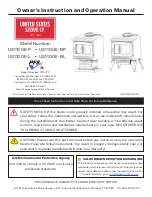
29
METAL CHIMNEYS
The advantages of these chimneys are:
Easy installation.
Slight changes in the direction to the chimney are possible, which provides greater
flexibility in the choice of where to install the stove.
Due to the existence of curved elbows, angles which obstruct the flue are eliminated
Make sure that all of the chimney pipes are well secured and the seals are completely tight.
1.2.2- TYPES OF INSTALLATIONS
Follow the manufacturer’s instructions when installing the chimney and accessories for the
appropriate clearances from the chimney to combustible materials, walls and ceilings.
There are basically two ways of installing a pre-fabricated metal chimney:
Interior or exterior installation
1.2.2.1- Interior Installation
An interior installation is when the chimney
passes inside the residence, through the
ceiling and roof.
Whenever
possible,
choose
an
interior
chimney. An interior chimney heats up more
quickly and retains its heat; thus promoting a
better flue and reducing the formation of
creosote.
When the chimney passes through floors and /
or ceilings, appropriate wall pass-through FIRE
guards should be installed. The insulation will
have a thickness of at least 50 mm. from the
chimney to the structure.
Protect the walls with wall protectors when the
chimney is not within the safety distance and
damage may arise. (See Fig.-3)
1.2.2.2- Exterior Installation
An exterior
installation is when the chimney passes through the wall behind the appliance
and then up the outside of the building.
An exterior chimney does not benefit from the warmth of being surrounded by the building, so
it usually lowers the flue temperature with respect to an interior chimney.
An exterior chimney’s flue is not as strong and may experience an increased build-up of
creosote.
If your installation is exterior, use double pipes with an insulated chamber.
1.2.3- GENERAL PRECAUTIONS
Only use prefabricated metal chimneys especially for high temperatures.
Do not connect a stove to any air distribution pipe or system.
Fig. 3
CLOSE-UP OF THE PASSING
OF CHIMNEY PIPES THROUGH
WALLS AND COMBUSTIBLE STRUCTURES
HEAT
INSULATION
STRUCTURE
METAL
EDGING
















































